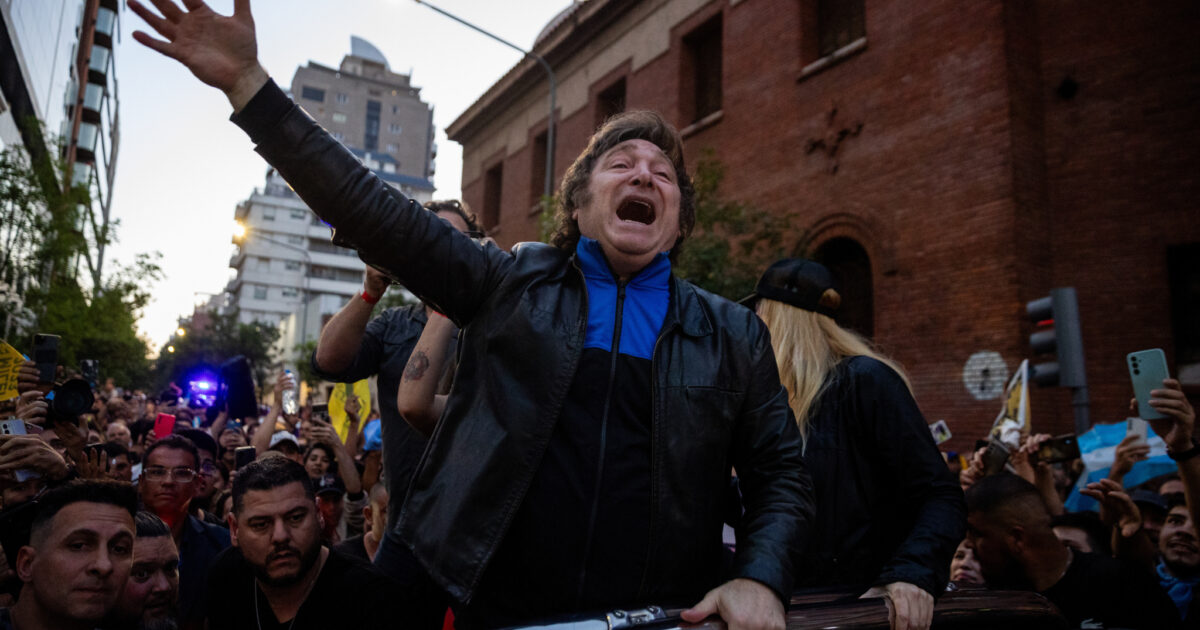
Across the globe, the far Right appears to be on the ascent. It has seized commanding heights in Giorgia Meloni’s Italy and Viktor Orbán’s Hungary, while formerly ostracized ethno-nationalist parties like the Sweden Democrats and the True Finns are now in governing coalitions. Shortly after this issue went to press, Argentina elected as president the voluble anarcho-capitalist Javier Milei, whose promise to commodify all facets of social life is accompanied by rabid anti-feminism and culture war invectives — “In my government there will be no cultural Marxism. I won’t apologize for having a penis. I shouldn’t feel guilty for being a white, blond, blue-eyed man” — as well as denialist apologias for the crimes of the military junta that ruled the country from 1976 to 1983. Across the Andes, in Chile, José Antonio Kast’s Republicans are surfing moral panics around immigration, feminism and indigenous rights as they seek to reanimate the authoritarian neoliberalism that the mass social rebellions of 2019 tried to bury. There’s a strong case to be made that the governments of Russia and India, and the movements supporting them, are piloting a 21st-century fascism. Meanwhile, Israel’s current government is run by the political descendants of those whom Albert Einstein and Hannah Arendt had no trouble calling fascists for their terroristic program of ethnic cleansing.
All of these reactionary movements have distinct histories and agendas, but we must recognize that we’re witnessing a global phenomenon: a far Right that’s more than happy to combine revanchist nationalisms with international coordination. With summits like the pan-Christian Right World Congress of Families, through joint proclamations like the red-baiting Madrid Charter, with entrepreneurs of resentment like Steve Bannon jetting around the globe to build nationalist networks, or through the international outreach of proudly “illiberal” academic institutions like Hungary’s Mathias Corvinus Collegium, the contemporary far Right has little truck with cultural isolationism. And, inspired by the 1970s French “New Right,” this coalition commonly celebrates ethno-national identities in all their sovereign difference and plurality — so long as those identities are Western, white, traditionalist or settler-colonial.
That the Left has no monopoly on making common cause across borders is a fact we ignore at our peril.
For all its internal differences — in economic vision, emphasis on religious morality and geopolitical outlook — this planetary wave of authoritarianism converges around three core elements: First, some version of the “great replacement” theory, the racist myth that there is a “globalist” plot to replace “native” populations with migrants.
Second, homophobic and transphobic moral panics claiming that society has been overtaken by an anti-family “gender ideology.”
Third, backlash against challenges to the racial-capitalist order, from U.S. right-wing attacks on “critical race theory” to the now-global “war on woke” (a term that’s been exported abroad, so that Italians now ludicrously refer to il wokismo, the French to le wokisme, and so on).
From Giorgia Meloni to the GOP, Bashar al-Assad to Vladimir Putin, everyone appears to be singing from the same hymnal, repeating some variation on these themes.
But it’s not enough for us to identify and rebut the international far Right’s shared narratives; we need to ask why culture wars are their preferred field of operations. The far Right’s media and electoral successes are significant: accelerating catastrophic climate change, endangering and immiserating the lives of its chosen targets, exacerbating the neoliberal assault on democratic public life. But they don’t reflect a proportional rise in reactionary social movements on the ground. The electoral far Right captures, nourishes and weaponizes many of what philosopher Baruch Spinoza called the “sad passions” — fear, resentment, hatred. But it rarely organizes them, except by wielding its legislative power to secure its supremacy and silence minorities. And in this, the international far Right represents a broader dynamic of depoliticization. It may choreograph mass gatherings — like Donald Trump’s campaign rallies, more wrestling arena than Nuremberg — but it avoids building any social fabric to counter anomie and atomization. While it provides a fertile breeding ground for violent factions and well-connected “lone wolves,” even these perverse forms of community-making are not at its core.
Rather, the rise of today’s far Right is a morbid symptom of our age of despair — of climate emergency, capitalist stagnation and growing awareness that postwar prosperity (however brief and uneven) is gone for good. It is also the legacy of the imperial ravages and racist frameworks of the so-called war on terror, as well as the implosion, neutralization or deflection of all the liberatory social movements that emerged after 2007–8, from Occupy to the Arab Spring, the indignados to student movements against privatization and austerity.
In a time of disillusionment, the global far Right is feeding off the false promises of a reformist social democracy and the failed efforts of true challenges to the status quo. As many progressives have lost hope in the viability of progress, the possessive and punitive instincts of the far Right become more attractive to a disoriented and disgruntled electorate. In many countries, a well-articulated political project is not necessary to sway a sizable proportion of the public to believe that excluding others will secure their meager slice of an ever-shrinking pie. And endless mobilizing for culture wars is, to paraphrase W.E.B. Du Bois, a cheap way of raising psychological wages while the real ones decline. Less bread, more circuses.
While we must all implacably fight the local and national variants of this far Right, it’s difficult to imagine a viable strategy for challenging it globally. The international anti-fascist movements of the past existed in a time when belief in the inevitability of a socialist future was strong; today, nostalgia for those popular fronts is not enough.
However, if we recognize that this worldwide reactionary political cycle is an effect of the cramping of our political horizons, then our response must be different. We might need to think about German philosopher Walter Benjamin’s call to “organize pessimism” and what that looks like today: not offloading the pathologies of contemporary capitalism onto the wretched of the Earth, nor looking for scapegoats to assuage our dread, but collectivizing our catastrophic condition — realizing that the imaginary security of a few can’t be bought at the cost of the disposability of most of humanity.
In the conspiratorial imagination of today’s far Right, we can glimpse, as in a funhouse mirror, what the Left we need looks like. To the far Right, the Left is an agent of monumental change: on the brink of destroying the oil industry, abolishing prisons and police, undermining private property and upending white Western civilization. In other words, the Left of the far Right’s nightmares is systematically undoing the causes of so much of our misery — it is organizing despair.
To leftists facing contemporary reaction in the waking world, one might say: Be everything they fear you are.
This post was originally published on this site be sure to check out more of their content.







